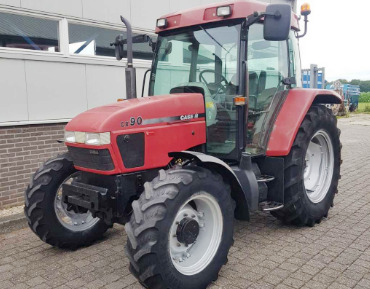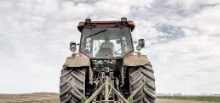________________________________________________________________________________________
| Home / Farm Tractors / Case IH Tractors / Case IH CX90 |
Case IH CX-90 Troubleshooting
 The
Case IH CX90 tractor was manufactured between 1998 and 2002. The Case IH CX90
tractor is powered by Perkins 1004.40T 4-cylinder direct injection turbocharged
diesel engine. A 243.5 cubic inches (4 L) engine has a cylinder bore of 3.93"
(100 mm), piston stroke of 5.00" (127 mm), and rated power of 84 hp (62.6 kW).
The
Case IH CX90 tractor was manufactured between 1998 and 2002. The Case IH CX90
tractor is powered by Perkins 1004.40T 4-cylinder direct injection turbocharged
diesel engine. A 243.5 cubic inches (4 L) engine has a cylinder bore of 3.93"
(100 mm), piston stroke of 5.00" (127 mm), and rated power of 84 hp (62.6 kW).
The Case IH CX90 is fitted with a 3 transmission options: 8x8 synchro-shuttle transmission, 16x8 powershift transmission, or 24x12 powershift transmission with creeper. The maximum forward speed - 24.4 mph (39.2 km/h), maximum reverse speed - 22.1 mph (35.5 km/h). The open center hydraulic system includes a gear pump with rated fluid flow of 15.7 gal/min (59.4 l/min). The main relief pressure is 173 bar (2500 psi).
The tractor is equipped with a hydrostatic power steering, differential hydraulic wet disc brakes, 7.50x16 (2WD) or 12.4R24 (4WD) front tyres, and 16.9-30 (2WD) or 16.9R34 (4WD) rear tyres. The wheelbase is 92.3" (2340 mm) for 2-wheel drive tractors and 93.7" (2370 mm) for 4-wheel drive tractors.
| Engine Troubleshooting |
| Engine starts hard or won't start |
Air trapped in fuel system - Bleed air.
Dirty fuel filter - Change filter element.
Defective injection nozzle - Test injection nozzles and change if necessary.
Water in the fuel system - Change fuel and repair fuel system.
Valve clearance is wrong - Adjust to proper valve clearance.
Fuel injection pump damage - Replace or rebuild injection pump.
| Engine starts and immediately shuts off |
Dirty air filter - Clean or change.
Fuel filter element is clogged - Clean the filter element.
Problems with fuel injection pump tightness - Inspect fuel injection pump for leaks.
Defective fuel injectors - Test and replace fuel injectors if necessary.
Fuel injection pump malfunctioning - Replace or repair injection pump.
| Engine shuts off suddenly while running |
Engine is not warmed up to the required temperature - Warm up engine as required.
Fuel filter element is dirty - Service the filter.
Air in the fuel lines - Bleed the fuel lines.
Fuel injection nozzles are faulty or clogged - Service or change injection nozzles.
Wrong setting of fuel injection pump timing - Use the correct fuel injection pump timing adjustment.
| Engine stalls while idling |
Improperly adjusted low idle speed - Correct low idle adjustment.
Fuel injection pump is not operating properly - Change pump or rebuild it.
Fuel injector fault - Replace fuel injectors.
Valve clearance is wrong - Correct valve clearance.
| Engine lacks power |
Dirty air filter - Clean air cleaner element.
Clogged or burnt injection nozzle - Test injection nozzles and change if necessary.
Incorrect fuel injection pressure - Check the fuel injection pressure and adjust if necessary.
Valve clearance is not correct - Correct valve clearance.
Improperly adjusted low idle speed - Adjust the low idle speed.
Dirt in the fuel hoses or lines - Service fuel lines and hoses.
Cylinder head gasket defective - Install a new gasket.
Leaking or damaged piston rings - Replace piston rings.
| Engine overheats |
Low coolant level - Fill radiator to proper level and check components for faults.
Low engine oil level - Check and refill engine oil.
Defective radiator cap or clogged radiator fins - Replace cap or clean radiator.
Fan belt is broken or worn - Install new fan belt.
Diesel engine is overloaded - Load reducing is recommended.
| Oil pressure is insufficient |
Low oil level - Checking oil level and add if necessary.
Clogged oil filter element - Replace or service engine oil filter.
Incorrect engine oil Drain crankcase and refill with correct oil.
Crankshaft bearing has excessive oil clearance - Change bearings.
Worn oil pump - Repair or replace.
| Engine knocking or noise |
Engine oil level is insufficient - Need to add engine oil.
Engine is not warmed up to the required temperature - Warm up to required temperature.
Improper setting of fuel injection pump timing - Adjust as recommended.
Incorrect low idle setting - Adjust the low idle speed.
Fuel injectors are dirty or defective - Change or clean fuel injectors.
Connecting rod is worn or not aligned - Connecting rod needs to be replaced or aligned.
Pistons are scored or worn - Replace the pistons as required.
| Transmission Troubleshooting |
| Low transmission oil pressure |
Transmission oil level is low - Fill up the transmission oil.
Transmission oil filter element clogging (if equipped) - Clean or replace the transmission filter.
Relief valve malfunction - Change relief valve.
| Transmission is excessively noisy |
Transmission oil insufficient - Fill up the transmission oil.
Transmission oil contamination - Change the oil.
Defective gears or improper backlash - Adjust backlash properly or replace the gears.
Bearings are cracked or worn - Bearings need to be changed.
Shift forks are worn or bent - Install new shift forks.
Shaft splines are worn or damaged - Install a new shaft.
| Gear hard to shift |
Gear shift linkage is worn or rusty - Lubricate or replace the shift linkage.
Worn or damaged gear shift forks - Replace the shift forks.
Worn gear shifting mechanism - Repair or change worn components if necessary.
Clutch is worn or not adjusted - Clutch needs to be replaced or adjusted.
| Transmission fluid leaking |
Too much oil in transmission - Drain the excess oil.
Seals or gaskets are worn - Replace worn seal or gaskets.
| Hydraulics Troubleshooting |
| Hydraulic fluid pressure is low |
Hydraulic oil level low - Need to add oil.
Dirty hydraulic fluid filter element - Replace filter element or clean if required.
Hydraulic pump failure - Install a new hydraulic fluid pump.
Incorrect adjusted hydraulic control valve - Adjust correctly.
Broken hydraulic cylinder - Install a new hydraulic cylinder or repair it.
Leaking hydraulic pipes - Inspect hydraulic system for leaks and repair it.
| Hydraulic system is overheated |
Main relief valve malfunction - Change relief valve.
Wrong hydraulic oil type - Fill up with the correct type of oil.
Hydraulic oil is dirty - Hydraulic oil change required.
There is air in the hydraulic system - Bleed hydraulic system.
| Hitch not lifting or hitch lifts slowly |
Hitch is under excessive load - Reduce hitch load.
Hydraulic oil level low - Checking hydraulic oil level and add if necessary.
Hydraulic fluid filter element is clogged - Change hydraulic filter element or clean if necessary.
Hydraulic pump is defective - Replace or repair hydraulic fluid pump.
Damaged main relief valve - Relief valve must be changed.
Hydraulic spool valve is defective - Repair or replace the valve.
Hydraulic cylinder malfunction - Install a new hydraulic cylinder or repair it.
Suction line is broken or disconnected - Connect or replace.
| Hitch won't drop or drops slowly |
Hydraulic spool valve is out of adjustment - Spool valve adjustment required.
Broken hydraulic cylinder - Replace or repair hydraulic cylinder.
The hitch has not been adjusted - Need to make adjustments.
Hitch cross shaft is damaged - Change the shaft.
| Hitch lift or drop is not smoothly |
There is air in the hydraulic system - Bleed hydraulic system.
Hydraulic fluid is contaminated - Fill up with new hydraulic fluid.
Damaged hydraulic pump - Install a new hydraulic fluid pump.
Faulty hydraulic control valve - Repair or replace the valve.
Damaged hydraulic cylinder - Repair or change hydraulic cylinder.
| Steering Troubleshooting |
| Steering is stiff |
Incorrectly fitted or worn steering column - Refit or replace the steering column.
Air in steering system - Bleed the steering system.
Improper toe-in - Adjust toe-in properly.
Front tyres are worn unevenly - Install new tyres.
Defective hydraulic steering pump - Install a new hydraulic steering pump.
Steering pump control valve is worn or stuck - Install a new flow control valve or clean it.
Low steering oil level - Fill up the steering oil.
| Excessive steering wheel free play |
Steering column coupling or shaft has maximum wear - Replace faulty part.
Worn steering pump - Check the steering pump and replace if necessary.
Steering linkage components are loose or worn - Check and replace as required.
| Tractor is pulling to left or right |
Front tyres wear unevenly - Change the tyres.
Incorrect toe-in - Check and adjust toe-in.
Worn or loose steering linkage joints - Check and replace as required.
Incorrectly adjusted or damaged front wheel bearings - Replace or adjust the bearings correctly.
| Electrical System Troubleshooting |
| Battery is not charging |
Wiring connections are loose or corroded - Tighten or service cable connections.
Battery terminal connectors are defective - Change terminal connectors.
Battery is worn - Battery change required.
Defective or loose belt - Adjust belt tension or change the belt.
| Starter cranks slowly |
Low battery voltage - Battery is drained, charge it.
Battery is not holding charge - Service charging system or replace battery.
Disconnected battery cables or bad terminals - Check wiring connections and replace or clean terminals.
| Starter is not working |
Battery is drained or worn - Need to charge or replace the battery.
Wiring is improperly connected or disconnected - Check wiring and connect properly.
Low battery voltage - Battery is drained, charge it.
Starter motor failing - Repair or replace starter.
________________________________________________________________________________________
________________________________________________________________________________________
| Farm Tractors Technical Specifications |
